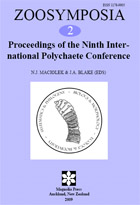Abstract
The aim of the present study was the development of species-habitat models for four Magelona species (Polychaeta: Magelonidae) found in the German Bight in the SE North Sea. Analyses were based on field data and data obtained from reexamination of material deposited in museum collections. In addition, data on environmental variables were retrieved from the sediment map by Figge (1981) and from long-term monitoring data sets. The statistical modeling technique applied was multivariate adaptive regression splines (MARS). Predictive accuracy measures were calculated for each model. The candidate model with highest discriminatory power was selected for predictive mapping.
Models with excellent predictive performance were developed for Magelona johnstoni, M. filiformis and M. alleni based on the analyzed set of environmental predictors. In each of the developed habitat models the most important predictor was a sediment parameter, either median grain size diameter (M. johnstoni) or mud content (M. alleni, M. filiformis). Salinity and water depth were also of importance. Model predictions were aimed to allow evaluation of habitat suitability for the investigated species in the German Bight. According to our results suitable habitats for M. johnstoni are numerous and a wide distribution of this species could be expected. Habitat suitability for M. filiformis in the German Bight was suggested to be high in areas with mud contents below 10 % at water depths between 25 and 35 m. The M. alleni habitat model indicated the presence of suitable habitats where sands with elevated mud contents are present and where water depths exceed 30 m.

